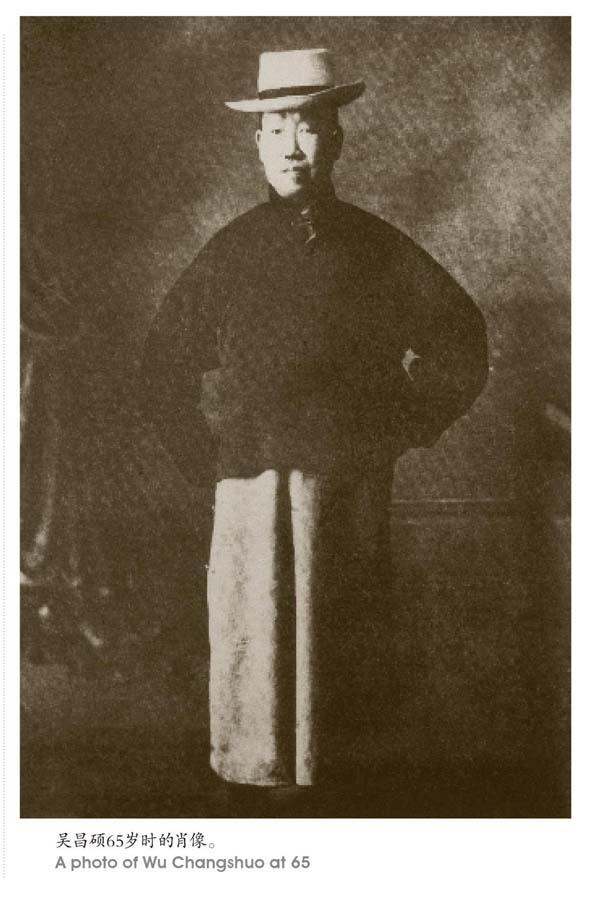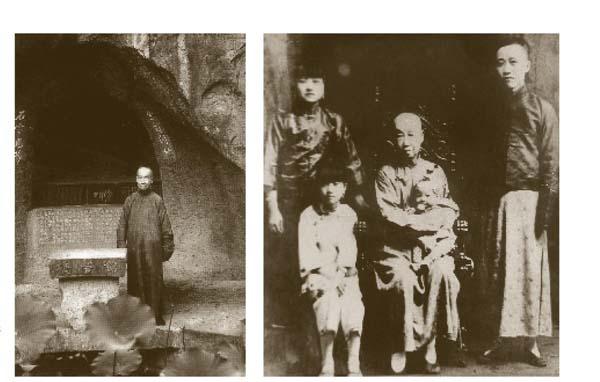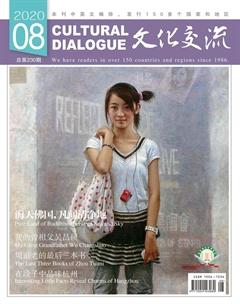我的曾祖父吴昌硕
吴越



“十年不到香雪海,梅花憶我我忆梅。何时买棹冒雪去,便向花前倾一杯。”这是一首题画诗,表达了我的曾祖父吴昌硕先生对杭州超山梅花的深厚感情。
2020年7月,杭州市余杭区超山风景区管理委员会在江南梅花圣地——超山梅花园拍摄电视片“艺术大师——吴昌硕”。
我的曾祖父吴昌硕,一生酷爱梅花,对梅有一种发自肺腑的真情。他写梅、书梅、画梅、刻梅,在他的艺术精品中,以梅花为主题的作品占了很大的比例。
他曾题诗“苦铁道人梅知己”,意寓永远做梅花的朋友。1927年11月,吴昌硕先生逝世,我祖父吴东迈遵父遗命,将他葬于超山。一代宗师吴昌硕从此长眠于超山十里梅海。
梅花象征着高洁,象征着拼搏,是不畏严寒与困境的发愤图强,是悠然的淡泊名利。吴昌硕先生爱超山梅花,选择与梅为伴,因为他就是梅,梅就是他。
作为中国近代集诗、书、画、印于一体的艺术大家,吴昌硕赋予了书画艺术探索创新的生命力。这个从贫困家境中走出来的人,以艺术为毕生追求,而且培养了诸多有影响力的书画艺术家,甚至还“跨界”培养了京剧大师梅兰芳和荀慧生。
学训诂学文学,他拜俞曲园为师
吴昌硕的家乡在浙江省安吉县。这里是中国的毛竹之乡,又是白茶之乡。山清水秀的一方山水,养育了大师吴昌硕。
吴昌硕早年受他父亲的影响,对书法、篆刻产生了浓厚兴趣。一般人家,一方印一般刻一面或者刻两面、两头,但是由于早年家境贫困,吴昌硕每得到一方印材,往往要六面全部刻满后,磨平再刻,反复练习。他练字是用青石板,把石板磨平,沾清水在石板上反复练习。他把家里的墙砖挖出来,凿了一方砚台,因为练字,甚至还磨穿过一方砚台。
刘海粟美术馆曾经就陈列过吴昌硕用过的一方砚台,是用非常普通的一块墙砖打造的,吴昌硕后来传给了儿子,后者又传到了下一代手中。我们现在讲文化自觉、文化自信、文化自强,老一辈艺术家为我们作了很好的示范。一方砚台看不出什么,但是传承了一种精神:有条件要上,没有条件创造条件也要上。
安吉曾是兵家必争之地,属军事要地。吴昌硕在17岁到22岁这五年中,正逢太平天国的后期,当时太平军在安吉烧杀抢掠,老百姓到处避难,他也在到处避难,做长工,打短工,啃树皮。但是他并没有泯灭自己的学习意志,反而锻炼了刻苦向上的求学精神。
吴昌硕把诗、篆刻、书法、绘画作为自己终身奋斗学习的目标。26岁后,他离开家乡,走访湖州、杭州、苏州、上海等地,拜师求学。29岁后,他和新婚的妻子分别,又到湖州、杭州、苏州求学。在杭州,拜俞曲园为师,学习训诂。在苏州,拜杨见山为师,学习文学、书法以及人品。杨见山还有一个号,叫“杨藐翁”,寓意藐视一切,傲骨铮铮。真正的艺术家个性都非常强烈,不唯唯诺诺。吴昌硕对杨见山非常崇拜和敬仰,他刻了一方印,称呼自己为“庸斋内老门生”(杨见山先生的号叫“庸斋”)。
他还到吴大澂家里担任家庭教师。吴大澂在当时的清朝廷任官,他把两个儿子交给吴昌硕指导。当时,苏州吴家是一个望族,家里收藏相当丰富,像一个小型博物馆。吴昌硕非常高兴,一边在吴大澂家里教书,一边在他家看很多社会上看不到的珍藏,如青铜器、鼎、彝器等一大批精品。吴大澂有一次问他的儿子,吴俊(吴昌硕早年的名字)在家里除了教书以外还做什么?他儿子回答说,每天就是在看我们家里面的收藏,记了很多笔记,写了很多诗。当时吴大澂对吴昌硕的这种学习精神非常满意。
后来,吴昌硕又到全国各地去拜访了一大批艺术家。他能够看到的、学到的都是第一手的资料,是原汁原味的艺术精品。这个过程对他的进步有很大的促进作用。
吴昌硕和家乡的感情非常深厚。他有一个名字叫“吴苍石”,他喜欢画大石头,因为安吉的山里面,这种类型的石头相当多。他还喜欢画家乡的竹子、山水,69岁以后,他作品上面都是以“吴昌硕”或者以“安吉吴昌硕”来落款。
写诗用功60年,夫人称他是诗人
吴昌硕的绘画,大气磅礴之余,还有一个鲜明的细节特点:他的每幅画作上面都有诗词提示。本来,画作上写个日期、签个名的做法在画界很常见,但吴昌硕并不仅仅是简单的日期、签名,他更多地把自己心中的想法表达在作品落款的诗词里面。他在诗歌方面,用了60年的功夫。吴昌硕的夫人也会写诗,她从没有把吴昌硕当作画家、书画家,一直说他是诗人。他的诗里面思想性非常强,他喜爱王维、杜甫的诗,也喜欢学习扬州八怪的作品。
他把老百姓喜闻乐见的内容作为诗词的题材。潘天寿是吴昌硕的弟子之一,潘天寿对吴昌硕非常敬佩,吴昌硕对潘天寿也非常厚爱。吴昌硕曾经写了对联给潘天寿,上联是“天惊地怪见落笔”,下联叫“巷语街谈总入诗”,意思是希望潘天寿从老百姓喜闻乐见的内容出发来进行创作。他不仅这样要求自己,也要求他的弟子深入生活,要把老百姓看的、听的、讲的,作为诗、书、画的内容。
所以,他的艺术永远和老百姓在一起。晚年,担任西泠印社社长以后,他为西泠印社写了对联,其中一句就是:“一耕夫来自田间”。别人把他称为泰斗、大师,他则把自己当成一个耕夫、一个农民。他说,“我永远是一个耕夫,在田里面耕也好,在书法上面也是一种耕,在绘画方面也是一种耕。”
吴昌硕的书法是他的艺术之根,他毕生以书法为友。而他书法的源头在哪里?答案是石鼓文。吴昌硕早年特别喜欢临摹石鼓文,他爱石鼓文残缺的古朴美和独特的结构。他扎实的书法功力,为他的篆刻和绘画打下了扎实的基础,也帮助他的艺术成就达到了“20世纪中国书法第一人”的称号。篆书一般圆体比较多,但吴昌硕经过自己几十年的修炼以后,形成了自己的风格:每个篆书结构比较偏长,线条有一种韧性。所以昌硕先生的篆书,有一种铁笔刚劲的韵味含在其中。他用篆书写就的《西泠印社记》,也是现在西泠印社收藏的镇社之宝。
绘画方面,吴昌硕经常画老百姓喜欢的蔬菜,如白菜。他一直讲“食蔬者长寿”,所以他画的蔬菜也很多。有趣的是,他画笔下的蔬菜线条全部是篆书线条。正因为他书法的功力深,简练而又刚劲的书体,使他的绘画充满了一种强烈的个性。你如果书法基础不好,像这种线条,包括一朵一朵梅花的花瓣是表现不出的。据我父亲讲,老先生画梅花的花瓣,他就是用篆书的笔法来画花瓣的。我们一直讲书画同源,以书为基础,画是一种表现的形式,正因为书法的基础好了,才为绘画的成功奠定了基础。他画寿桃,寿桃的线条就是他书法的线条,正因为他书法藏锋笔力的刚劲,所以线条也能承载着这么丰满的一对寿桃。
他的詩词、绘画、书法,为他的中国画奠定了扎实的基础,从而达到了气势磅礴、意境丰满、内涵丰富、色彩高度完美的结合。即便是其将近80岁时的绘画作品,依然充满强烈的生命力,体现了一种民族向上的奔放精神。
诗书画印精绝,还有卓越的教育成果
吴昌硕不仅是诗、书、画、印四绝,而且在艺术教育方面,几位学生都颇有成就。其中包括沙孟海、王个簃、陈半丁、刘海粟、潘天寿、张大千、王一亭、梅兰芳等。梅兰芳是京剧大师,但实际上早在20岁的时候,他就在上海向吴昌硕先生求教,学习书画艺术。吴昌硕晚年和王一亭交往特别深,他们两位亦师亦友。也是因为在艺术教育上的卓越成果,吴昌硕被世界艺术界评为五绝完人。
不仅对中国的艺术教育作出贡献,吴昌硕还培养了日本的弟子,其中包括许多位日本有名的书画大家,为中日民间的友好艺术交流做了大量的工作。1913年,西泠印社建立10周年的时候,正式对外营运交流。当年的篆刻书画界公推吴昌硕为西泠印社的首任社长。1996年,日本福冈地区的艺术家为了纪念吴昌硕,在日本北九州市专门建立了吴昌硕胸像纪念碑。吴昌硕诞辰170周年时,日本各地也举办了吴昌硕纪念活动。这都反映了吴昌硕带给日本的积极影响。
晚年时,吴昌硕把自己的家藏大批捐献出来,要求王一亭办一个学校,就是昌明艺术专科学校。吴昌硕自己没有经过学校的系统学习,他靠两条腿走遍了大半个中国,他凭自己的意志努力,在老师的指点下,站上中国的艺术高峰。但他说:我一定要办一个学校,让想学习而没有条件学习的年轻人,在这个学校里面得到正统的学习。
一位艺术家一定要有一种责任感。吴昌硕赈灾、办学校、抢救西泠印社的国宝……他不仅在艺术方面攀上了高峰,对社会的发展也有巨大的担当。
吴昌硕特别喜欢杭州余杭超山的梅花。晚年的吴昌硕一直在超山画梅、写梅。老先生逝世之前,就跟我祖父讲:我去世以后,你们就把我葬在超山的梅花树旁。他曾经自己写了一首《苦铁道人梅知己》,他说:我永远是梅花的朋友。
My Great Grandfather Wu Changshuo
By Wu Yue
Wintersweet was the lifetime lover of my great-grandfather Wu Changshuo (1844–1927), whose high attainments in seal-engraving, painting and calligraphy made him a heavyweight member in the hall of fame of contemporary Chinese arts. His deep love for wintersweet infiltrated his versatile artworks. In 1927, the art master rested in peace in the wintersweet-perfumed Chaoshan Hill in Yuhang, Hangzhou.
Born into a poor, academic family in Anji in present-day Huzhou in northern Zhejiang, Wu Changshuo pursued throughout his lifetime the highest possible stage of traditional Chinese arts, and influenced many cultural notables, even including Mei Lanfang (1894-1961) and Xun Huisheng (1900-1968), two Peking Opera masters of the 20th century in China.
Anji, where Wu Changshuo was born, is “Chinas capital of bamboo and white tea”. The countys picturesque scenery of mountains and rivers contributed to the art genes of a young Wu Changshuo. Influenced by his father, Wu Changshuo became interested in calligraphy and seal carving at a very young age. Family poverty never bothered the boy, who made the best of each stone to practice seal carving and practiced calligraphy with water. An inkslab made by Wu Changshuo with a piece of wall brick was once displayed at the Liu Haisu Museum in Shanghai.
Wu never stopped his pursuit in arts during the warring years from 1861 to 1866. The scarcity of life materials further built his character, and at the age of 29, he left his hometown and his newly-wedded wife for more advanced study in Suzhou, where he further honed his skills in literature and calligraphy, and Hangzhou, where he learned exegesis from Yu Quyuan (1821-1907).
In his Suzhou years, Wu Changshuo became the tutor of the two sons of Wu Dacheng, a high-ranking court official of the Qing Dynasty (1644-1911). The familys collection of ancient artifacts opened the eye of Wu Changshuo. He also traveled a lot, visiting the countrys art masters and trying his best to build connections. In those years, he made sure that what he saw was the best of the best, and such a mentality paved the way for his achievements in later years.
Wu Changshuo also called himself “Cangshi” (weather-beaten rock). The name shows his love for stone. The artist used “Wu Changshuo” or “Wu Changshuo from Anji” for almost all his artworks made after the age of 69, in order to show his spiritual connection with his hometown.
Wus unique approach to art, later known as the “Wu style,” was inspired by traditional calligraphic technique. His compositions were often accompanied by poetic inscriptions. Interestingly, in the eye of his wife, who also wrote poems, Wu Changshuo was more a poet than a painter and calligrapher. Poetry remained his lifetime passion. He was a big fan of Wang Wei, Du Fu and the “Yangzhou Eight Eccentrics”.
Wu Changshuo and Pan Tianshou (1897-1971), who was one of Wus disciples, were friends for life. “Life is the best source of poems,” Wu Changshuo once wrote a couplet as words of advice to Pan. It is no exaggeration to say that the art of Wu Changshuo is from ordinary life and for the ordinary people. In his later years as the president of the Xiling Seal-engravers Society, he humbly called himself a “farmer filling my duties in the art realms”.
Calligraphy is the “root” of the virtuosos peerless attainments in all the realms he specialized in. Wus calligraphic style was first inspired by “shiguwen” (inscriptions on drum-shaped stone blocks of the Warring States period of China), which he copied a lot in his younger years with great passion. The primitive simplicity of the inscriptions rendered his calligraphy a unique, unsurpassable quality, as best illustrated in , written in the seal script by Wu Changshuo.
Interestingly, such a calligraphic style is also noticeable in the artists paintings, most strikingly in his “vegetable” and “wintersweet” pieces. For Wu Changshuo, painting is a bifurcation of calligraphy. His incomparable calligraphic mastery blossomed into a freestyle he manipulated with ease in all the other art genres he pursued. Wu did not start painting until the age of 30. Combining bright colors and sharp contrasts with bold, simple brushstrokes, he created a unique style that is rich in life. Such fierce vitality never waned with age, as is fully demonstrated in works he created in his 80s.
Wu Changshuo was also a master of art education. He was the most important mentor to Wang Yiting, an influential figure in the artist circle of Shanghai in the 1920s and 1930s. Of Wus numerous followers also were some Japanese painting artists and calligraphers.
Wu Changshuo donated most of his collections of ancient artifacts and artworks and collaborated with Wang Yiting to fulfill a long-cherished wish, that is, to open an art school. The school evolved into the Hangzhou-based China Academy of Arts, one of the most prestigious art institutions in China.
Wu Changshuo spent the last few of his twilight years in Yuhang, admiring the legendary beauty of the wintersweet blossoms in Chaoshan Hill, about 30 kilometers from present-day downtown Hangzhou.

